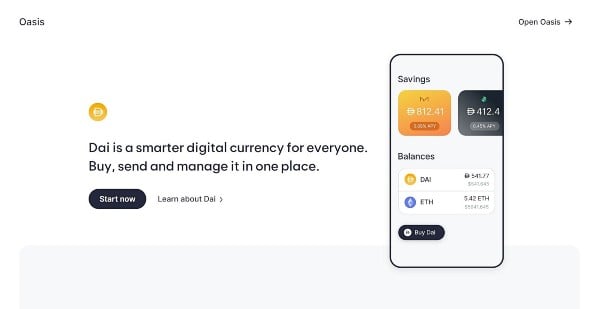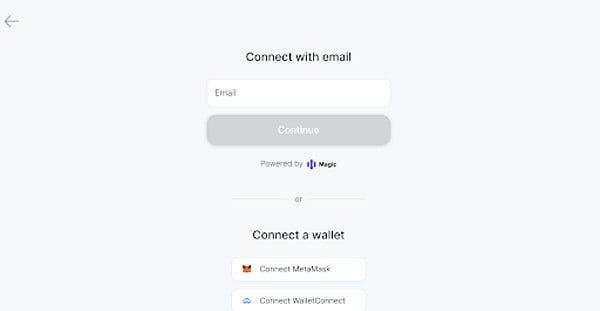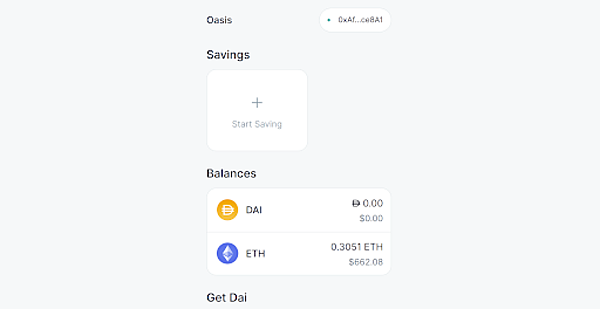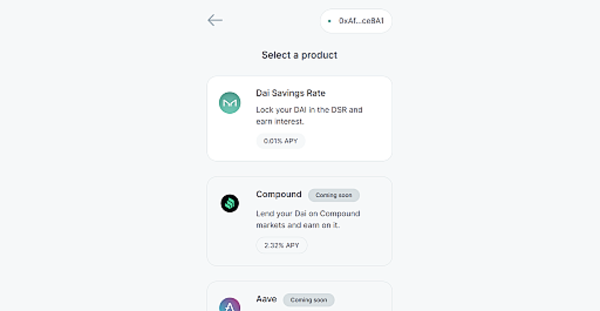DAI is a US dollar (USD) stablecoin minted by the decentralised finance (DeFi) platform, MakerDAO. MakerDAO allows users to deposit cryptocurrencies as collateral in return for DAI loans. Launched in 2017, MakerDAO allowed investors to finally experience the immense potential of leveraging cryptocurrency holdings.
DAI manages to achieve something that is nearly impossible, keeping an Ethereum-based token pegged to the US dollar. The token's stability relies solely on market forces, which are driven by the MakerDAO governing community. DAI keeps in line with the US dollar thanks to automatic smart contracts that liquidate positions, incentivising and repressing loan creation and by leveraging the MakerDAO governance token, MKR.
What is DAI staking and how does it work?
DAI is a stablecoin, but a stablecoin unlike any other. Perhaps the most well-known stablecoin is Tether. Tether keeps itself pegged to the USD in a very traditional way, by holding equivalent value assets. In theory, every Tether token is supported by a real-world amount of USD, keeping the price stable.
DAI uses a far more dynamic set of protocols to keep its price stable. DAI is unique because it is backed by cryptocurrency collateral. For every loan created, new DAI tokens are minted. When a loan is repaid, the DAI is burned and the collateral is released. Every loan needs to be over-collateralised by 150%. This creates a buffer if the value of cryptocurrency assets depreciates, thus providing stability to DAI. If the value of the collateral falls below 150%, cryptocurrency assets are automatically sold to cover the difference, again making the price of DAI stable.
Alongside cryptocurrency collateral and automatic liquidations, DAI supply is controlled by stability fees. Stability fees are charged for the generation of new DAI tokens. The fees can be increased or decreased to encourage or discourage loan creation, and can increase and decrease the supply of DAI. This control helps to anchor the value of DAI to 1 USD. If all of the above protocols fail to mitigate liquidations, the MakerDAO platform can also mint and sell the governance token MKR to cover any shortfalls.
The concepts employed by MakerDAO are cutting-edge, hold immense potential and allow DAI to maintain its price stability. However, alongside loan creation, DAI tokens can also be used to earn extra rewards through staking.
Technically speaking, staking refers to locking cryptocurrencies into a "proof-of-stake" blockchain. By doing so it helps to validate transactions and secure the network. However, DAI is not associated with a native blockchain. DAI is associated with the DeFi protocol MakerDAO, which leverages the Ethereum blockchain. In this case, staking can refer to the different ways DAI tokens can be locked away to generate interest.
There are 3 primary ways to stake DAI tokens and each method has distinct advantages and disadvantages.
Back to topHow to stake DAI
Staking through the MakerDao system – the Dai Savings Rate
The easiest way to stake DAI is via the Dai Savings Rate, or DSR, protocol. The DSR is a native smart contract hosted directly on the MakerDao system. Users can lock DAI into a DSR contract, which will then generate interest at the current savings rate.
The DSR is by far the easiest method of staking DAI. It functions largely like a traditional bank savings account. However, the DSR provides a few extra benefits such as no minimum deposit and the ability to withdraw DAI at any point.
Due to the unique nature of the MakerDao system, the DSR is highly variable. MakerDao governance token holders can vote to adjust the DSR at any time, as it provides another tool for managing DAI stability. By changing the DSR, the community can manipulate the supply and demand of DAI, which then helps to keep the token firmly pegged to the US dollar.
How to stake DAI within MakerDAO Step 1. DAI's front-end application. Users can access the MakerDAO protocol through DAI's front-end app, which is called Oasis. On the home page click "Open Oasis" in the top right corner. Step 2. Connect wallet. Once on the Oasis application, you will be prompted to connect your Web 3.0 digital wallet. Select your wallet that contains DAI tokens and follow the prompts.
Step 2. Connect wallet. Once on the Oasis application, you will be prompted to connect your Web 3.0 digital wallet. Select your wallet that contains DAI tokens and follow the prompts.
 Step 3. Savings. Once on the Oasis application, click the "Start Saving" box.
Step 3. Savings. Once on the Oasis application, click the "Start Saving" box.
 Step 4. Dai Savings Rate and set-up. On the next screen click the "Dai Savings Rate" box. You will be prompted to set up your Web 3.0 digital wallet. These steps will ensure your Web 3.0 wallet can interact with the Oasis application.
Step 4. Dai Savings Rate and set-up. On the next screen click the "Dai Savings Rate" box. You will be prompted to set up your Web 3.0 digital wallet. These steps will ensure your Web 3.0 wallet can interact with the Oasis application.
 Step 5. Deposit. Enter the amount you wish to deposit into a DSR contract and click confirm.
Step 6. Confirm. Confirm the transaction through your Web 3.0 digital wallet. Once transferred, your DAI tokens will begin to earn interest at the current DAI savings rate.
Step 5. Deposit. Enter the amount you wish to deposit into a DSR contract and click confirm.
Step 6. Confirm. Confirm the transaction through your Web 3.0 digital wallet. Once transferred, your DAI tokens will begin to earn interest at the current DAI savings rate.
Staking through an exchange
DAI can frequently be staked using common exchanges, such as Binance or Coinbase. These exchanges usually promote these services as DeFi staking. This term is slightly misleading as the process of staking through an exchange is by definition centralised.
Despite the misnomer, staking DAI on an exchange provides 2 major advantages. It's quick, and it's easy. There's no need to worry about collateral, wallets or complicated procedures. The annual percentage yield (APY) on an exchange will vary daily, but that's no different than staking using the DSR on the MakerDAO protocol.
Platforms that offer staking
Finder Score for crypto exchanges
To make comparing even easier we came up with the Finder Score. Supported coins, account fees and features across 28 cryptocurrency trading platforms are all weighted and scaled to produce a score out of 10. The higher the score the better the exchange - simple.
DeFi lending
True DeFi lending is the most complicated but potentially most lucrative way to stake DAI tokens.
Decentralised finance (DeFi) applications are not controlled by a centralised institution. All protocols are built into the underlying code and govern how transactions work, as in the case of MakerDao. There is no one entity overseeing and regulating the process.That freedom allows cryptocurrency investors to do almost anything with their assets – buy, sell, leverage and lend. DeFi applications such as decentralised exchanges (DEXs) or lending and borrowing protocols rely on user-supplied liquidity. This liquidity is often collected in the form of liquidity pools. Liquidity pools are a pot of cryptocurrency assets that other users can then trade or exchange with. In return for depositing assets into a liquidity pool, liquidity providers earn a share of all fees collected. Each liquidity pool will have an associated interest rate, which will vary depending on the demand for tokens in the pool.
To earn interest from DeFi lending, a user will need to find a DAI liquidity pool on either a DEX, such as Uniswap, or a lending protocol, such as AAVE. The liquidity pool will have an associated APY. Once DAI tokens have been deposited into the liquidity pool a user will start earning rewards. Rewards may be received as DAI or as the native cryptocurrency token of the DeFi application.
Note: Liquidity pools on DEXs often contain a cryptocurrency pairing. For example, DAI:ETH. In this example, a user would need to deposit equal amounts of DAI and ETH into the liquidity pool. Back to topHow much can I earn with DAI staking?
Staking DAI can be a useful way to earn interest on idle holdings. The amount earned from staking DAI will vary based on the staking method chosen.
Depositing DAI tokens into the DSR on MakerDAO will offer variable returns. These returns have been as high as 8% but also can drop to as low as 0%. Returns from the DSR are governed by holders of the MakerDAO governance token, MKR. It is in the token holder's interest to vary the DSR and maintain DAI's stability.
Lending DAI through another DeFi application can be complicated but potentially more profitable. Potential earnings will be directly correlated to the demand for a chosen DAI liquidity pool. If the demand is high, rewards will increase. As a decentralised stablecoin, DAI is often one of the most sought after cryptocurrencies on DeFi applications.
Unlike other cryptocurrencies, the real-world dollar value will not vary depending on the price of DAI. Theoretically, when withdrawing staked DAI tokens that have accrued interest, the equivalent US dollar value should be higher. This would not be the case when staking a volatile cryptocurrency such as ETH.
Back to topIs staking DAI safe?
Each staking method should be chosen based on personal risk and reward inclinations. Staking DAI via the DSR provides a very straightforward method to earn interest. The system is associated with the MakerDAO protocol and should therefore be one of the safest options. However, like all decentralised applications that rely on smart contracts, there are inherent risks.
Smart contracts are programmed by human developers which leaves them open to human error and potential exploitation. As they are designed to be immutable, any malfunctions or manipulations could lead to a loss of funds. In the past, the MakerDAO platform has suffered hacking scares, but to date, no funds have ever been taken.
Depositing DAI in a centralised exchange is also relatively safe. These exchanges provide some of the best security in the world due to the inherent risk of digital assets. However, like the DSR, DeFi staking through exchanges also relies on smart contracts.
Although potentially more profitable, lending assets to DeFi applications comes with a greater set of inherent risks. On top of using smart contracts, DeFi applications can be extremely interconnected, which creates the risk of cascading failure. Secondly, as most liquidity pools are designed around cryptocurrency pairings (DAI:ETH), their use can sometimes lead to impermanent loss. For more information on the risks associated with liquidity pools, please see our full guide here.
As DAI is a stablecoin, the risks of staking are greatly reduced in comparison to other cryptocurrencies. Some forms of staking can require locking tokens up for a set period. This means that a user can not react to volatile market movements and mitigate a loss in value. Other than DeFi lending, a user does not have to worry about volatile price movements. After accruing additional interest, the staked DAI should increase in real-world value.
Back to topVerdict
Staking Dai is an excellent way to increase token holdings and is accessible for most cryptocurrency investors. Depositing tokens through an exchange is likely the easiest way to earn interest, followed closely by locking DAI within a MakerDAO Dai Savings Rate contract. The DSR also allows a user to actively contribute to the stability of the MakerDAO ecosystem. Although returns can be small, they can be stable and are often higher than an average bank account savings rate.
Lending DAI tokens to DeFi applications requires the most expertise and is associated with the most risk. However, by harnessing the volatility of the cryptocurrency markets it can offer lucrative opportunities.
Back to top